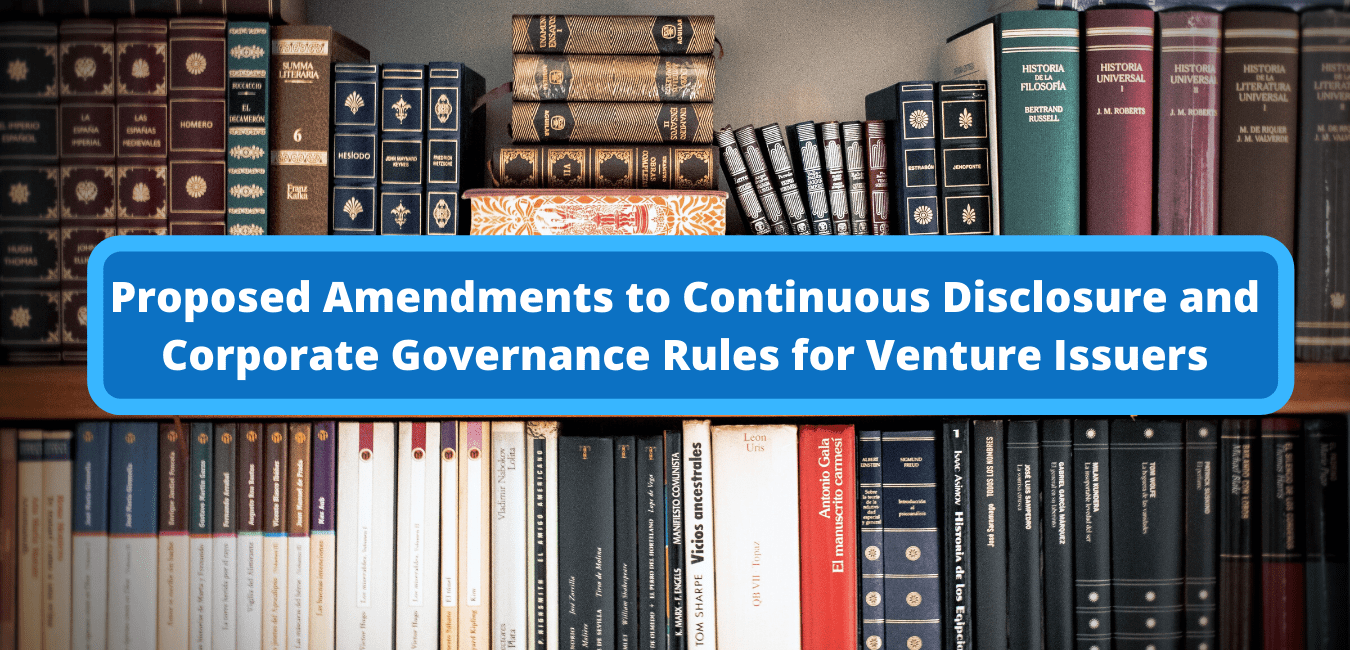In May 2014, the Canadian Securities Administrators (the “CSA”) released proposals aimed at streamlining the continuous disclosure and corporate governance regime for venture issuers. The previous proposals released by the CSA in July 2011 and September 2012 were withdrawn in July 2013 citing feedback that the benefits of the previous proposals were outweighed by the burden of transition to the new regime.
The current proposal would amend the current continuous disclosure and corporate governance regime with respect to the following:
1. Interim MD&A obligations
2. BAR requirements
3. Executive Compensation disclosure
4. Prospectus disclosure
5. AIF disclosure
6. Audit committee composition
1. Quarterly Highlights
Currently, venture issuers are required to file quarterly interim management’s discussion and analysis pursuant to the requirements of Form 51-102F1 – Management’s Discussion and Analysis in order to provide a narrative explanation of the issuer’s performance, financial condition and future performance. The MD&A is filed at the same time as financial statements for the interim period and supplements the financial statements.
The CSA is proposing to streamline the quarterly interim disclosure filed by venture issuers without significant revenue by permitting the filing of a Quarterly Highlight disclosure document focused on the issuers operations and liquidity with the goal of providing an update on the business activities and financial condition of the issuer. The discussion on operations and liquidity would include known trends, demands, major operating statistics and changes thereto, commitments, events, expected or unexpected, or uncertainties that have materially affected the venture issuer’s operations and liquidity in the quarter or are reasonably likely to have a material effect going forward. Venture issuers without significant revenue would not be required to update its annual MD&A in the Quarterly Highlight disclosure document unless there are material changes to plans disclosed in the annual MD&A.
The Quarterly Highlight disclosure document would also include a description of the material effects resulting from a change of accounting policies during the interim period as well as Changes to accounting policies during the period.
In order to determine whether it has earned significant revenue in a financial year, venture issuers should use the actual total revenue that is reported in its annual financial statements and not annualize the revenue earned over a portion of the year.
2. BAR Requirements
Within 75 days of completing a significant acquisition of a business (the “Target”), reporting issuers must file a business acquisition report in Form 51-102F4 – Business Acquisition Report (the “BAR”), which must include audited financial statements for the most recently completed financial year for each Target acquired as well as pro forma financial statements.
In order for an acquisition to be a significant acquisition for a venture issuer, one of the following significance tests, fully enumerated in National Instrument 51-102 – Continuous Disclosure Obligations (“NI 51-102”) must be satisfied:
(a) The Asset Test: The venture issuer’s proportionate share of the consolidated assets of the acquired business exceeds 40% (20% for non-venture issuers) of the consolidated assets of the venture issuer and the Target for the most recently completed financial year of each;
(b) The Investment Test: The venture issuer’s consolidated investments in and advances to the Target as at the acquisition date exceeds 40% (20% for non-venture issuers) of the consolidated assets of the venture issuer as at the last day of the most recently completed financial year of the venture issuer, excluding any investments in or advances to the Target as at that date; or
(c) The Profit or Loss Test: The venture issuer’s proportionate share of the consolidated specified profit or loss of the Target exceeds 40% (20% for non-venture issuers) of the consolidated specified profit or loss of the venture issuer calculated using the audited annual financial statements of each of the venture issuer and the Target for the most recently completed financial year of each.
The proposal from the CSA is to increase the threshold for venture issuers from 40% to 100% and to remove the requirement to provide pro forma financial statements with the BAR.
3. Executive Compensation Disclosure
Currently, reporting issuers (venture and non-venture) are required to disclose executive compensation in Form 51-102F6 – Statement of Executive Compensation (“Form 51-102F6”). The CSA is proposing that venture issuers disclose executive compensation under a new Form 51-102F6V – Statement of Executive Compensation – Venture Issuers (“Form 51-102FV6”). Under the proposal, a venture issuer would only be required to provide disclosure of one additional executive officer other than its CEO and CFO.
The summary compensation table as well as the tables that disclose grants and security compensation grants would be simplified with only a single table required for directors and named executive officers for each for each of the two most recently completed financial years.
Tables for compensation securities and the exercise of compensation securities replace the incentive plan award tables in Form 51-102F6. Broadly, disclosure of details of the compensation securities issued, held and exercised are required, removing the fair value calculations currently required.
The compensation discussion and analysis requirement is removed by the proposal, including the performance graph (venture issuers are exempt from this requirement), description of share based and option based compensation and compensation governance. In its place, the proposal contemplates a more specific discussion of the compensation of each named executive officer (“NEO”), an explanation of who determines director and NEO compensation and how and when such compensation decisions are made. An exemption exists if such information would be prejudicial to the venture issuer.
4. Prospectus Disclosure
Currently, National Instrument 41-101 – General Prospectus Requirements (“NI 41-101”) requires a private company conducting its initial public offering (“IPO”) to include audited financial statements for each of the three most recently completed financial years ended more than 120 days before the date of the prospectus, if the private company will be a venture issuer following the completion of the IPO (90 days for non-venture private companies) as well as a three year description and history of the business.
The CSA’s proposal would reduce the number of years of audited financial statements required to be included by venture issuers to each of the two most recently completed financial years and permit venture issuers to provide a two year description and history of the business.
In addition, the proposal would make further amendments to NI 41-101 to correspond with the amendments to NI 51-102 discussed above, such as allowing venture issuers:
(a) without significant revenue, to utilize the disclosure for the Quarterly Highlights disclosure documents in the prospectus rather than interim MD&A;
(b) to comply with the disclosure requirements of Form 51-102FV6 in the prospectus; and
(c) to include BAR level disclosure in the prospectus where a significant acquisition meets the 100% threshold.
5. Audit Committee Composition
With limited exceptions, National Instrument 52-110 – Audit Committees (“NI 52-110”) requires that issuers have an audit committee composed of at least three independent and financially literate directors. Venture issuers are exempted from the aforementioned composition requirements of NI 52-110.
The TSX Venture Exchange requires issuers to have an audit committee comprised of at least three Directors, the majority of whom are not Officers, employees or Control Persons of the Issuer or any of its Associates or Affiliates.
The Canadian Securities Exchange does not specify corporate governance requirements and does not feel it is appropriate to prescribe a higher threshold for CSE issuers than prescribed by applicable laws, including NI 52-110.
The CSA is proposing that the audit committee of venture issuers be composed of at least three directors, the majority of whom must not be executive officers, employees or control persons of the venture issuer or an affiliate of the venture issuer.
6. AIF Disclosure
The CSA’s proposal also amended Form 51-102F2 – Annual Information Form to conform with revisions made to National Instrument 43-101 – Standards of Disclosure for Mineral Projects in 2011.
Final Remarks
The comment period for the CSA’s current proposal ended on August 20, 2014. It remains to be seen whether, or to what extent, the proposal will make its way into the Canadian securities law regulatory environment. From a venture issuer’s perspective it is positive that the CSA recognizes that the current continuous disclosure and corporate governance regime should be amended to better fit the resources and capabilities of venture issuers.
About the Author: Jeremy S. Budd, the principal of BUDD Law, was called to the Ontario Bar in 2007 after completing his articling term and the JD/MBA program at Osgoode Hall Law School and the Schulich School of Business. Before founding BUDD Law, Jeremy was a partner at one of Bay Street`s top boutique securities law firms. Mr. Budd has extensive experience as a corporate securities lawyer and regularly assists reporting issuers with ongoing disclosure, corporate governance matters and a variety of financing, corporate and M&A transactions. Jeremy is also an experienced corporate secretary and has served as a public company director. Further information about BUDD Law can be found at www.budd-law.ca or by contacting Mr. Budd by phone at 416-840-6632 or by email at jeremy@budd-law.ca
Since 2005 ITB Solutions has provided listings development services to stock Exchanges in Canada such as the Canadian Securities Exchange. ITB Solutions currently provides New Listing Services to the NEO Exchange. We assist companies with the listing application and managing the process to become publicly tradable in Canada, as well as offering advice on how to make the most of your public listing. You can reach Jeffrey Stanger at 647-500-0492 or by email at jeffrey@itbsolutions.ca










